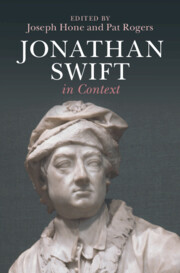Book contents
- Jonathan Swift in Context
- Jonathan Swift in Context
- Copyright page
- Contents
- Notes on Contributors
- Preface
- Acknowledgements
- Chronology
- Abbreviations
- Part I Personal
- Part II Publishing History and Legacy
- Part III Literary Background
- Part IV Genres
- Part V The External World
- Part VI Social and Intellectual Topics
- Chapter 35 Philosophy
- Chapter 36 Science
- Chapter 37 Race
- Chapter 38 Material Culture
- Chapter 39 Gender
- Chapter 40 Colonialism
- Chapter 41 The Body
- Chapter 42 Demography
- Chapter 43 Food
- Chapter 44 Economics
- Further Reading
- Index
Chapter 37 - Race
from Part VI - Social and Intellectual Topics
Published online by Cambridge University Press: 02 May 2024
- Jonathan Swift in Context
- Jonathan Swift in Context
- Copyright page
- Contents
- Notes on Contributors
- Preface
- Acknowledgements
- Chronology
- Abbreviations
- Part I Personal
- Part II Publishing History and Legacy
- Part III Literary Background
- Part IV Genres
- Part V The External World
- Part VI Social and Intellectual Topics
- Chapter 35 Philosophy
- Chapter 36 Science
- Chapter 37 Race
- Chapter 38 Material Culture
- Chapter 39 Gender
- Chapter 40 Colonialism
- Chapter 41 The Body
- Chapter 42 Demography
- Chapter 43 Food
- Chapter 44 Economics
- Further Reading
- Index
Summary
This chapter disentangles some of the threads that linked history, demography, and ethnicity in Swift’s imagination. The first part of the chapter looks at the predominant theory of English ethnicity during Swift’s lifetime: the notion that the modern English people were direct descendants of the Anglo Saxons, who were themselves descended from the Gothic peoples of antiquity. The second part considers Swift’s attitude towards the native Irish people. And the final section addresses the treatment of the Yahoos in the fourth voyage of Gulliver’s Travels, in which, it seems, conventional racial tropes dissolve into broad-bottomed misanthropy.
Keywords
- Type
- Chapter
- Information
- Jonathan Swift in Context , pp. 295 - 302Publisher: Cambridge University PressPrint publication year: 2024

